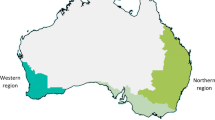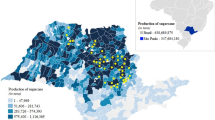Abstract
This research evaluated the factors that influenced cotton (Gossypium hirsutum L.) producers to adopt remote sensing for variable-rate application of inputs. A logit model estimated with data from a 2005 mail survey of cotton producers in 11 southern USA states was used to evaluate the adoption of remote sensing. The most frequently made management decisions using remote sensing were the application of plant growth regulators, the identification of drainage problems and the management of harvest aids. A producer who was younger, more highly educated and had a larger farm with irrigated cotton was more likely to adopt remote sensing. In addition, farmers who used portable computers in fields and produced their own map-based prescriptions had a greater probability of using remote sensing. The results suggest that value-added map-making services from imagery providers greatly increased the likelihood of a farmer being a user of remote sensing.
Similar content being viewed by others
References
Ashley, M. D., & Rea, J. (1975). Seasonal differences from ERTS imagery. Photogrammetric Engineering and Remote Sensing, 41, 713–719.
Barham, B. L., Foltz, J., Jackson-Smith, D., & Moon, S. (2004). The dynamics of agricultural biotechnology adoption: Lessons from rBST use in Wisconsin, 1994–2001. American Journal of Agricultural Economic, 86, 61–72.
Batte, M. T., & Arnholt, M. W. (2003). Precision farming adoption and use in Ohio: Case studies of six leading-edge adopters. Computers and Electronics in Agriculture, 38, 125–139.
Belsley, D. A., Kuh, E., & Welsch, R. E. (1980). Regression diagnostics. New York, NY: Wiley.
Bourland, F. M., Oosterhuis. D. M., & Tugwell, N. P. (1992). Concept for monitoring growth and development of cotton plants using main-stem node counts. Journal of Production Agriculture, 5, 532–538.
Brooks, N. L. (2001). Characteristics and production costs of U.S. cotton farms. Stat. Bull. 974-2. Washington, DC: U.S. Department of Agriculture, Economic Research Service.
Brown, T., & Wesch, R. (2006). Opti-grow aerial imagery. In D. Richter (Ed.), Proceedings beltwide cotton conference (pp. 2293–2294). San Antonio, TX, 3–6 Jan 2006. Memphis, TN: National Cotton Council America.
Cochran, R. L., Roberts, R. K., English, B. C., Larson, J. A., Goodman, W. R., Larkin, S. R., Marra, M. C., Martin, S. W., Paxton, K. W., Shurley, W. D., & Reeves, J. M. (2006). Precision farming by cotton producers in eleven southern states: Results from the 2005 southern precision farming survey. Research series 01-06. Knoxville, TN: The University of Tennessee Institute of Agriculture, Department of Agricultural Economics.
Cody, R. P., & Smith, J. K. (2005). Applied statistics and the SAS programming language (5th ed.). Upper Saddle River, NJ: Prentice Hall.
Daberkow, S. G., McBride, W. D., & Ali, M. (2003). Implications of remote sensing imagery and crop rotations for nitrogen management in sugar beet production. Paper presented at the American Agricultural Economics Association annual meeting 27–30 July 2003, Montreal, Quebec, CA. http://agecon.lib.umn.edu/cgi-bin/pdf_view.pl?paperid=8767&ftype=.pdf. Accessed 16 July 2007.
Dalal, R. C., & Henry, R. J. (1986). Simultaneous determination of moisture, organic carbon, and total nitrogen by near-infrared reflectance, spectrophometry. Soil Science Society of America Journal, 50, 120–123.
Dillman, D. A. (1978). Mail and telephone surveys: The total design method. New York, NY: Wiley.
Hong, L., Lascano, R. J., Barnes, E. M., Brooker, J., Wilson, L. T., Bronson, K. F., & Segerra, E. (2001). Multispectral reflectance of cotton related to plant growth, soil water and texture, and site evaluation. Agronomy Journal, 93, 1327–1337.
InTime Inc. (2007). InTime: Making precision pay. http://www.gointime.com. Accessed 12 February 2007.
Kennedy, P. (2003). A guide to econometrics (5th ed.). Cambridge, MA: MIT Press.
Khanna, M. (2001). Sequential adoption of site-specific technologies and its implications for nitrogen productivity: A double selectivity model. American Journal of Agricultural Economics, 83, 35–51.
Kirkpatrick, M. T., Walton, J. J., Dodds, D. M., Reynolds, D. B., & O’Hara, C. G. (2005). Site-specific plant growth regulator applications based on aerial imagery. In P. Dugger & D. Richter (Eds.), Proceedings beltwide cotton conference (p. 2950). New Orleans, LA, 4–7 Jan 2005. Memphis, TN: National Cotton Council America.
Larson, J. A., Roberts, R. K., English, B. C., Cochran, R. L., & Sharp, T. (2004). A case study analysis of a precision farming system for cotton. In P. Dugger & D. Richter (Eds.), Proceedings beltwide cotton conference (pp. 539–542). San Antonio, TX, 5–9 Jan 2004. Memphis, TN: National Cotton Council America.
Mallarino, A. P., & Wittry, D. J. (2004), Efficacy of grid and zone soil sampling approaches for site-specific assessment of phosphorus, potassium, pH, and organic matter. Precision Agriculture, 5, 131–144.
Napier, T. L., Robinson, J., & Tucker, M. (2000), Adoption of precision farming within three mid-west watersheds. Journal of Soil and Water Conservation, 55, 135–141.
Pinter, P. J., Jr., Hatfield, J. L., Schepers, J. S., Barnes, E. M., Moran, M. S., Daughtry, C. S. T., & Upchurch, D. R. (2003). Remote sensing for crop management. Photogrammetric Engineering and Remote Sensing, 69, 647–664.
Plant, R. E. & Munk, D. S. (1999a). Application of remote sensing to irrigation management in California cotton. In P. C. Robert, R. H. Rust, & W. E. Larson (Eds.), Proceedings 4th international conference on precision agriculture (pp. 1511–1522). St. Paul, MN, 19–22 July 1998. Madison, WI, USA: ASA, CSSA, and SSSA.
Plant, R. E., & Munk, D. S. (1999b). Using infrared aerial photography to help plan defoliation. California Cotton Review, 52, 3–5.
Plant, R. E., Munk, D. S., Roberts, B. A., Vargas, R. N., Rains, D. W., Travis, R. L., & Hutmacher, R. B. (2001). Application of remote sensing to strategic cotton management. Journal of Cotton Science, 5, 30–41.
Popp, J, & Griffin, T. (2001). Adoption trends of early adopters of precision farming in Arkansas. In P. C. Robert, R. H. Rust, & W. E. Larson (Eds.), Proceeding 5th international conference on precision agriculture (unpaginated). Bloomington, MN, 16–19 July 2000. Madison, WI, USA: ASA, CSSA, and SSSA.
Ritchie, G. L., Bednarz, C. W., Whitaker, J, & Mills, C. (2005). Cotton irrigation timing using remote sensing. In P. Dugger & D. Richter (Eds.), Proceedings beltwide cotton conferences (pp. 1956–1960). Orleans, LA, 4–7 Jan 2005. Memphis, TN: National Cotton Council America.
Rivers, D., & Vuong, Q. H. (1988). Limited information estimators and exogeneity tests for simultaneous probit models. Journal of Econometrics, 39, 347–366.
Roberts, R. K., English, B. C., Larson, J. A., Cochran, R. L., Goodman, W. R., Larkin, S. L., Marra, M. C., Martin, S. W., Shurley, W. D., & Reeves, J. M. (2004). Adoption of site-specific information and variable-rate technologies in cotton precision farming. Journal of Agricultural and Applied Economics, 36, 143–158.
Robinson, E. (2004). Venture charts course with precision. Delta Farm Press. http://deltafarmpress.com/index.html. Accessed 16 July 2007.
Robinson, E. (2006). Aerial imagery works best with footprints in the field. Delta Farm Press. http://deltafarmpress.com/index.html. Accessed 16 July 2007.
SAS Institute Inc. (2004). SAS 9.1.3 help and documentation. Cary, NC: SAS Institute Inc.
Torbett, J. C., Roberts, R. K., Larson, J. A., & English, B. C. (2007). Perceived importance of precision farming technologies in improving phosphorus and potassium efficiency in cotton production. Precision Agriculture, 8, 127–137.
U.S. Department of Agriculture, National Agricultural Statistics Service. (2004). 2002 Census of agriculture. Washington DC: U.S. Department of Agriculture, National Agricultural Statistics Service. http://www.nass.usda.gov/census/census02/volume1/us/index2.htm. Accessed 16 July 2007.
Willers, J. L., Jenkins, J. N., Ladner, W. L., Gerard, P. D., Boykin, D. L., Hood, K. B., McKibben, P. L., Samson, S. A., & Bethel, M. M. (2005). Site-specific approaches to cotton insect control sampling and remote sensing analysis techniques. Precision Agriculture, 6, 431–52.
Wooldridge, J. (2002). Econometric analysis of cross section and panel data. London: MIT Press.
Zarco-Tejada, P. J., Ustin, S. L., & Whiting, M. L. (2005). Temporal and spatial relationships between within-field yield variability in cotton and high-spatial hyperspectral remote sensing imagery. Agronomy Journal, 97, 641–653.
Acknowledgements
We wish to thank Cotton Incorporated and the Experiment Stations in Florida, Louisiana, Mississippi, North Carolina, and Tennessee, USA, for funding this research. We also wish to thank Dayton Lambert and the anonymous reviewers for their useful suggestions that greatly improved this paper.
Author information
Authors and Affiliations
Corresponding author
Rights and permissions
About this article
Cite this article
Larson, J.A., Roberts, R.K., English, B.C. et al. Factors affecting farmer adoption of remotely sensed imagery for precision management in cotton production. Precision Agric 9, 195–208 (2008). https://doi.org/10.1007/s11119-008-9065-1
Published:
Issue Date:
DOI: https://doi.org/10.1007/s11119-008-9065-1




